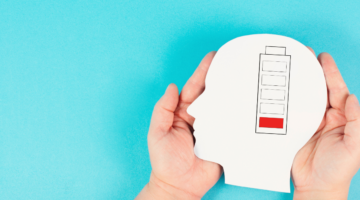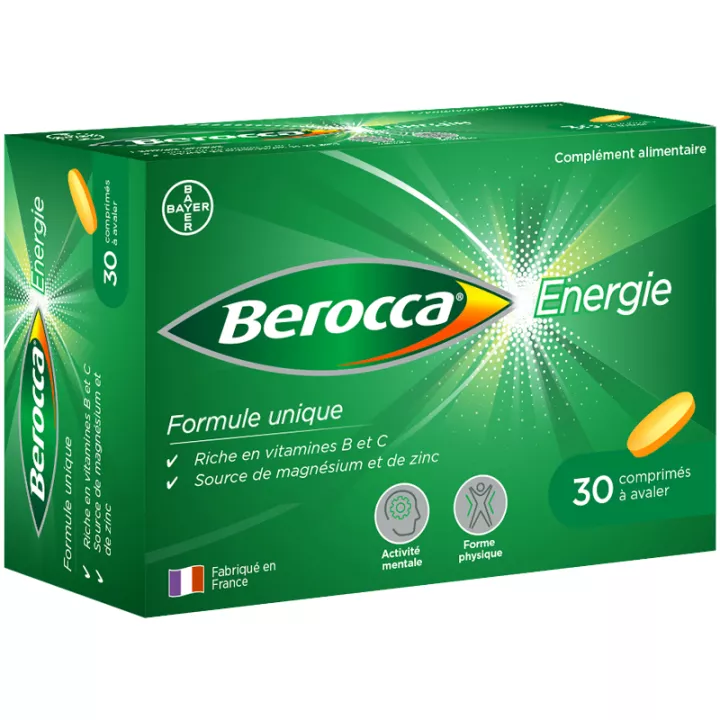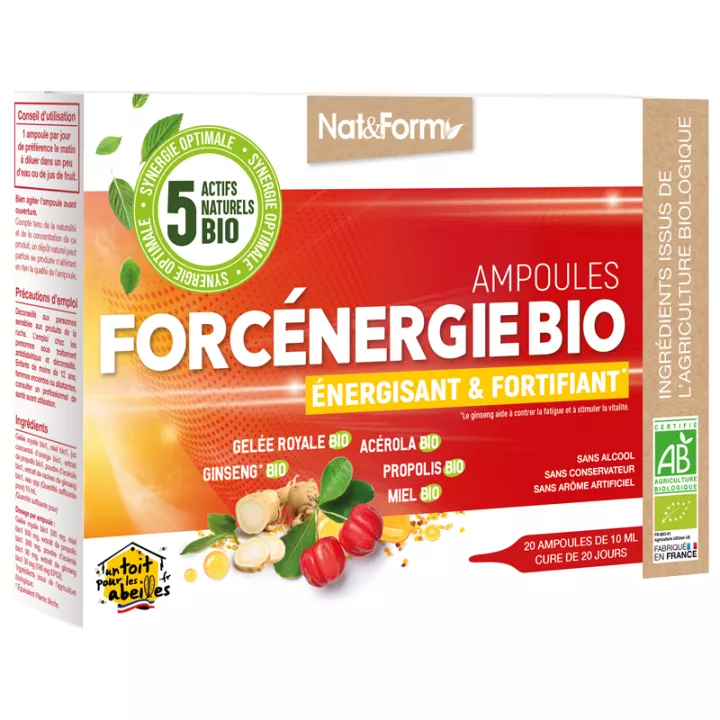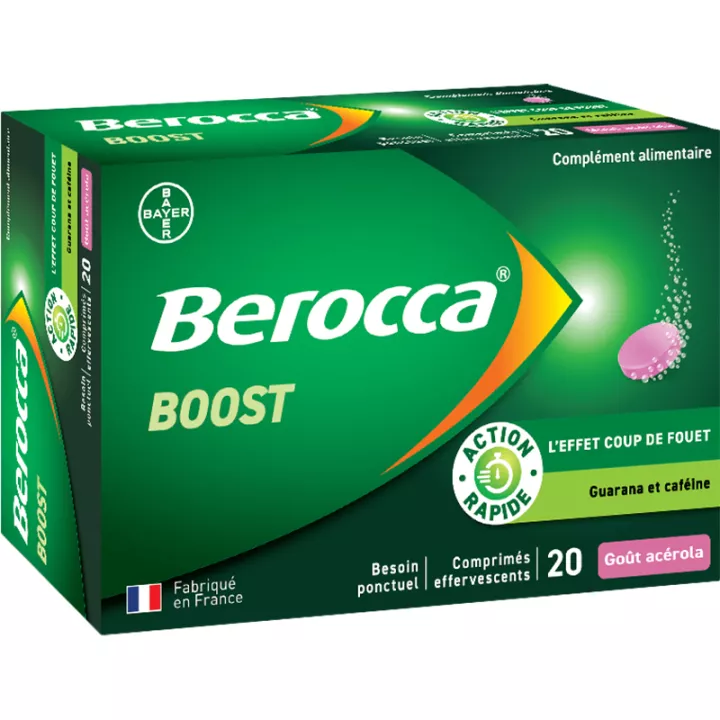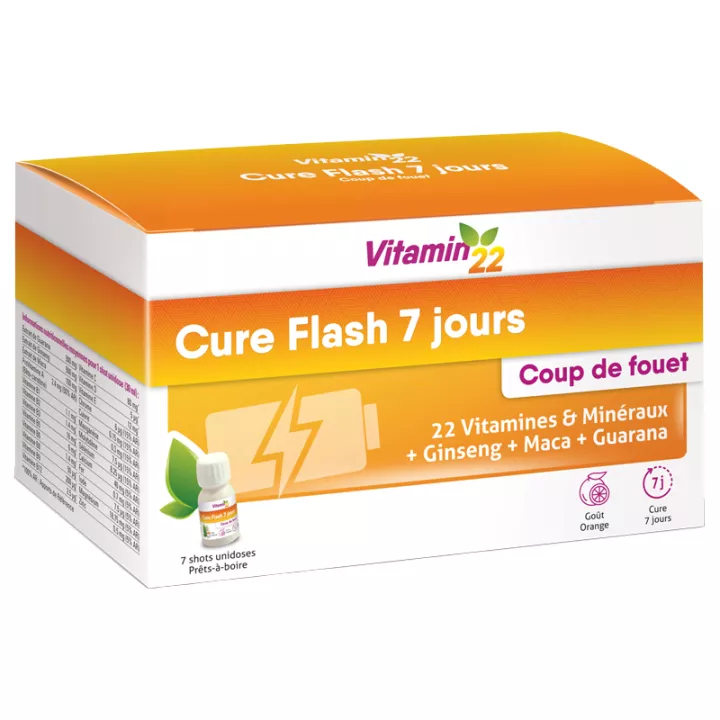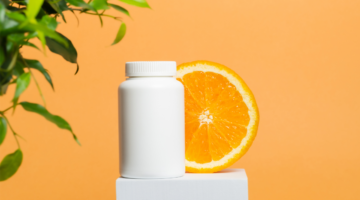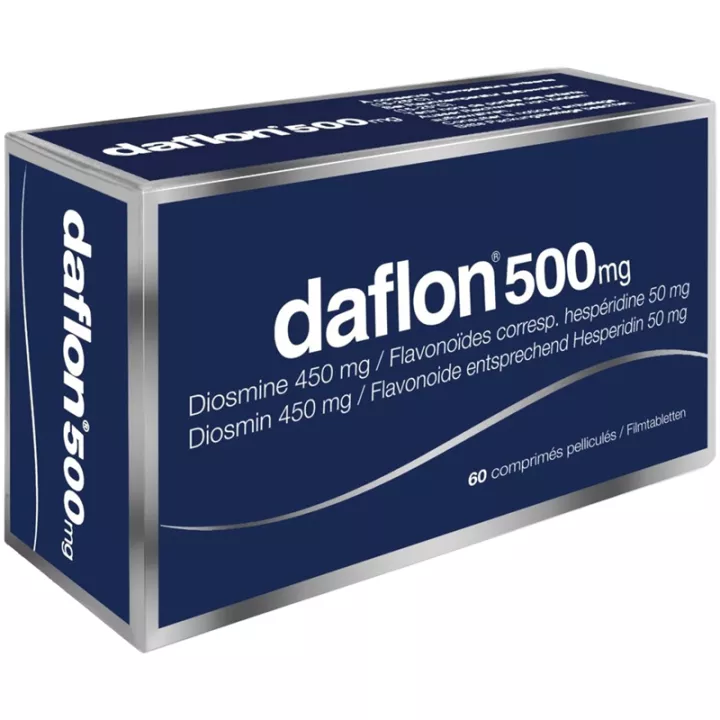Boost your vitality with Berocca Energie Multivitamin Tablets
Berocca Energie Multivitamin Tablets are recommended for temporary fatigue.
With your busy lifestyle, it's hard to stay in top physical and mental shape!
Long working days, evenings out with friends... It's hard not to feel like you're running out of steam.
Berocca Energie® is a clinically proven medication that combines vitamins and minerals to help you regain your physical and mental vitality!
Stop waking up feeling tired, lacking energy and having trouble concentrating... With Berocca Energie®, you'll be at your best!
Rich in essential minerals and vitamins B and C.
This nutritional supplement is also available as Berocca effervescent tablets from our online pharmacy, at a fair price.
Indications for Berocca Energie
This Berocca Energie dietary supplement contains magnesium, calcium, zinc and vitamins B and C. These minerals and vitamins are essential for the metabolism.
Berocca Energie is used in the treatment of magnesium deficiency and in the event of symptoms that may suggest a lack of magnesium: irritability, temporary fatigue, minor sleep disorders, palpitations, muscle cramps, tingling.
Boost your vitality with essential nutrients
A powerful dose of magnesium for optimal energy
Give your daily energy a boost with Berocca Energie tablets. These tablets contain a special combination of magnesium, calcium, zinc and vitamins B and C, which are essential for a healthy metabolism. Magnesium, in particular, plays a crucial role in cellular energy production, helping to combat temporary fatigue and improve your vitality.
Magnesium is known for its stimulating properties, which can help you stay focused, alert and energetic throughout the day. Whether you need a boost to start your day on the right foot, or you're feeling a little sluggish in the afternoon, Berocca Energie is here to support you. With a powerful dose of magnesium in every tablet, you'll quickly feel the benefits of this essential mineral.
Live life to the full with a complete vitamin formula
Vitamins B and C, your allies for optimum health
Berocca Energie's formula doesn't just supply magnesium. The tablets are also packed with vitamins B and C, which play a vital role in energy production, immune support and overall health.
B vitamins, such as vitamin B12 and vitamin B6, are renowned for their ability to convert food into usable energy for your body. By taking Berocca Energie, you give your body the nutrients it needs to maximize the efficiency of this conversion, helping you get the most out of your food.
What's more, the vitamin C in Berocca Energie boosts your immune system, protecting you from external aggressors. So you can concentrate on your activities without worrying about the little illnesses that can slow you down.
Say goodbye to fatigue and welcome new vitality
A complete solution to combat deficiencies and symptoms of fatigue
Temporary fatigue, irritability, minor sleep disorders, palpitations... These symptoms can be signs of magnesium deficiency, an essential element often overlooked. Berocca Energie is specially designed to help you combat these symptoms and restore the energy you need to enjoy life to the full.
By taking Berocca Energie tablets regularly, you can make up for any magnesium deficiency and support your metabolism. Muscle cramps and unpleasant pins and needles can be reduced, leaving you feeling more relaxed and recovering faster.
Don't let fatigue and low energy stop you from enjoying every moment. Choose Berocca Energie to recharge your body and regain radiant vitality.
How do I take Berocca Energie tablets?
For adults (aged 15 and over), as a 30-day course of treatment: at the first signs of magnesium deficiency (temporary fatigue, whether physical or mental, etc.).
Take 1 or 2 tablets a day, preferably in the morning.
The usual recommended duration of treatment is 1 month.
What is Berocca Energie composed of?
The active ingredients of this remedy are Thiamine hydrochloride (Vitamin B1), Riboflavin (Vitamin B2), Pyridoxine hydrochloride (Vitamin B6), Cyanocobalamin (Vitamin B12), Nicotinamide (Vitamin PP or B3), Pantothenic acid (Vitamin B5), Biotin (Vitamin B8 or H), Folic acid (Vitamin B9), Ascorbic acid (Vitamin C), calcium, magnesium, zinc.
Other ingredients include: Citric acid anhydrous, sodium bicarbonate, sodium carbonate, sodium chloride, acesulfame potassium, aspartam, beet red (E162), beta-carotene 1% SD, orange flavor (orange essential oil, maltodextrin, gum arabic), polysorbate 60, mannitol, sorbitol, isomalt.
| |
p cp efferv |
p cp |
| Thiamine (vitamin B1) |
15 mg |
14.6 mg |
| Riboflavin (vitamin B2) |
15 mg |
15 mg |
| Pantothenic acid (vitamin B5) |
23 mg |
23 mg |
| Pyridoxine (vitamin B6) |
10 mg |
10 mg |
| Cyanocobalamin (vitamin B12) |
10 μg |
10 μg |
| Ascorbic acid (vitamin C) |
500 mg |
500 mg |
| Biotin (vitamin B8) |
0.15 mg |
0.15 mg |
| Nicotinamide (vitamin PP) |
50 mg |
50 mg |
| Folic acid (vitamin B9) |
0.4 mg |
0.4 mg |
| Calcium |
100 mg |
100 mg Magnesium |
| Magnesium |
100 mg Magnesium |
100 mg |
| Zinc |
10 mg |
10 mg |
| Sodium |
263 mg |
|
| Aspartam |
+ |
|
| Lactose |
|
+ |
Excipient: Mannitol
Other excipients (specific to certain forms): Citric acid anhydrous, Aspartam, Beta-carotene, Sodium bicarbonate, Coco oil, Croscarmellose Na salt, Yellow iron oxide, Black iron oxide, Red iron oxide, Glucose, Gum arabic, Hypromellose, Lactose monohydrate, Magnesium stearate, Maltodextrin, Orange flavour, Orange essence, Polydextrose, Polysorbate 60, Potassium, Potassium acesulfame, Povidone K 90, Beet red, Sodium, Sodium carbonate, Sodium chloride, Talc, Titanium dioxide
Precautions for use
A balanced and diversified diet usually provides sufficient quantities of vitamins and minerals. Prolonged use of vitamins is not justified without medical advice.
Under treatment, dark yellow urine is normal: this is due to vitamin B2.
Possible side effects of Berocca Energie: Digestive intolerance.
Contraindications of Berocca Energie dietary supplement
Berocca Energie should not be used in the following cases:
- severe renal insufficiency,
- excess calcium in the blood or urine,
- calcium lithiasis,
- phenylketonuria (effervescent tablets contain aspartam).
Caution: vitamin C is broken down in the body into oxalic acid, which can lead to the formation of urinary tract stones. Do not take large doses of vitamin C for long periods without medical advice.
The quantity of vitamin B12 contained in this medicine is insufficient to treat anemia due to a deficiency of this vitamin.
Effervescent tablets contain significant amounts of salt (sodium).
Interactions of Berocca Energie with other substances
Interact with cyclins, biphosphonates or iron-containing drugs at least 2 hours before taking Berocca Energie.
Tell your pharmacist or doctor if you are taking a medicine containing digoxin or a diuretic (e.g. hydrochlorothazide).
There are also food interactions: foods known to be rich in oxalic acid (spinach, rhubarb, sorrel, cocoa, tea) or phytic acid (chocolate, wholegrain cereals, pulses) may reduce calcium absorption. It is therefore recommended to take this medicine at a distance from meals containing these foods.
Fertility, pregnancy and breast-feeding
This dietary supplement contains only substances presumed safe for use during pregnancy and lactation. Nevertheless, do not use it for prolonged periods without consulting your pharmacist or doctor.
Presentation
Practical and convenient, Berocca Energie® is available in film-coated tablets (box of 30 or 60).
Our expert pharmacy advice
To feel in top form, there's nothing better than eating 5 fruits and vegetables a day... everyone knows that. But did you know that vegetables lose vitamins when cooked? And that your fruit, between picking and the supermarket shelf, becomes less rich in vitamins?
To make sure you don't lose any of their goodness, opt for short distribution channels: visit your local grower or market. You'll discover new flavours...bursting with V-I-T-A-M-I-N-E-S!
- Get enough sleep to be more lively.
Getting enough sleep is one of the keys to harnessing energy. During deep sleep, your body takes advantage of the opportunity to "repair" the damage done during the day and distribute the nutrients absorbed during the day. What's more, it's been proven that "good sleepers" increase their powers of memorization and concentration. So a good night's sleep is synonymous with a great day!
Move for a better life.
Whether you're hiking, jogging or boxing... Physical activity is as good for your brain as it is for your body.
- Smile in the face of adversity
What do you do when life throws you a curve ball? You try to laugh it off, don't you? Well, you're right! Simply because the simple act of laughing triggers the production of endorphins, hormones that reduce anxiety and protect the immune system.
Laughing is also an excellent exercise because it relaxes you and forces you to breathe deeply. A real pressure relief valve!
When the brain stops being stimulated, it stagnates. When, on the contrary, this marvellous sponge - of which, according to Albert Einstein's legendary quote, we only use 10 or 15% of its potential - is just waiting to be fed! How can we do this? By learning a new language, delving into the culture of a foreign country, communicating with interesting people and so on.
So let's stay students all our lives - it's good for the mind!
